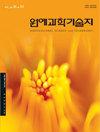Seasonal Fluctuation of Freezing Tolerance and Soluble Sugar Content in Three Sweet Persimmon Cultivars
IF 0.8
4区 农林科学
Q3 HORTICULTURE
Korean Journal of Horticultural Science & Technology
Pub Date : 2021-06-01
DOI:10.7235/HORT.20210027
引用次数: 2
Abstract
Sweet persimmon (Diospyros kaki Thunb.) exhibits insufficient freezing tolerance (FT) in comparison with other temperate fruit trees. Information about FT of sweet persimmon is scarce. In this study, FT was analyzed in three sweet persimmons cultivars, ‘Fuyu’, ‘Taishuu’, and ‘Romang’, using an electrolyte leakage method for two successive years (Year 1, November 2017 to April 2018; Year 2, November 2018 to April 2019). Current-year shoot samples from 8-year-old sweet persimmon trees of each cultivar were collected to analyze FT in an experimental orchard (Pear Research Station, Naju, Korea). Average daily air temperatures increasingly declined from November 2017, reaching the minimum in mid-January 2018. They then steadily increased until April 2018 (Year 1). Patterns of average daily air temperatures of Year 2 were similar to those of Year 1 except that they reached the minimum at the end of December 2018. FT of the three cultivars constantly increased during cold acclimation (from November to January), whereas FT decreased during deacclimation (from February to April) for both years. Shoot samples (from Year 2) of the most freezing-tolerant ‘Romang’ and the most freezing-susceptible ‘Taishuu’ were used for soluble sugar analysis with HPLC. In both ‘Taishuu’ and ‘Romang’, total soluble sugar content was the highest in December 2018 and started to decrease from January 2019 until April 2019. Fructose and glucose contents showed the same pattern as total soluble sugar. Meanwhile, sucrose and maltose of ‘Taishuu’ and ‘Romang’ were detected minimally throughout the whole experimental period. These results indicated that fluctuations of total soluble sugar, fructose, and glucose contents paralleled FT of the three cultivars (p < 0.001). Additional key words: carbohydrate, cold acclimation, deacclimation, freezing injury, low temperature三个甜柿品种抗寒性和可溶性糖含量的季节变化
甜柿(Diospyros kaki Thunb.)与其他温带果树相比,表现出耐冻性不足。关于甜柿子FT的信息很少。在本研究中,使用连续两年(第一年,2017年11月至2018年4月;第二年,2018年11月到2019年4月)的电解质渗漏方法,对三个甜柿子品种,“扶余”、“太硕”和“罗芒”的FT进行了分析。在实验果园(梨研究站,Naju,Korea)中,从每个品种的8年生甜柿子树上采集当年的枝条样本,以分析FT。自2017年11月以来,日均气温不断下降,2018年1月中旬达到最低水平。然后,它们稳步增长,直到2018年4月(第一年)。第二年的日均气温模式与第一年相似,只是在2018年12月底达到最低。三个品种的FT在冷驯化期间(从11月到1月)不断增加,而在去气候期间(从2月到4月),FT在这两年都有所下降。用高效液相色谱法对耐冻性最强的“罗芒”和最易冻的“太硕”的茎部样品(第2年)进行可溶性糖分析。在“太硕”和“罗芒”中,总可溶性糖含量在2018年12月最高,从2019年1月到2019年4月开始下降。果糖和葡萄糖含量显示出与总可溶性糖相同的模式。同时,在整个实验期间,“太硕”和“罗芒”的蔗糖和麦芽糖含量最低。这些结果表明,三个品种的总可溶性糖、果糖和葡萄糖含量的波动与FT相似(p<0.001)
本文章由计算机程序翻译,如有差异,请以英文原文为准。
求助全文
约1分钟内获得全文
求助全文
来源期刊
CiteScore
2.00
自引率
0.00%
发文量
0
审稿时长
1 months
期刊介绍:
Horticultural Science and Technology (abbr. Hortic. Sci. Technol., herein ‘HST’; ISSN, 1226-8763), one of the two official journals of the Korean Society for Horticultural Science (KSHS), was launched in 1998 to provides scientific and professional publication on technology and sciences of horticultural area. As an international journal, HST is published in English and Korean, bimonthly on the last day of even number months, and indexed in ‘SCIE’, ‘SCOPUS’ and ‘CABI’. The HST is devoted for the publication of technical and academic papers and review articles on such arears as cultivation physiology, protected horticulture, postharvest technology, genetics and breeding, tissue culture and biotechnology, and other related to vegetables, fruit, ornamental, and herbal plants.

 求助内容:
求助内容: 应助结果提醒方式:
应助结果提醒方式:


